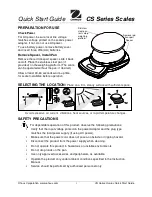
G&G GmbH | Operating elements
10
For an external calibration, you need a reference weight that has a smaller tolerance than the scales
readout. During the calibration the scale will “learn” how “heavy” a specific weight is at the local
environment conditions and adjust according to this. Due to this, it is important that the reference weight
has a smaller tolerance than the scale can determine the weight. We recommend to use weights that are
produced within the OIML-Tolerance classes (E2 for example). Which weight is required for which scale,
can be found in the table of technical data.
7.1
Calibration
The scale must be turned on for at least the required warm up time, display is on “0”.
Press and hold the “CAL” key until the display changes to "C XXX".
XXX is the required weight of the reference weigh, when it displays "C 100" now a 100g weight must be
placed in the middle of the plateframe. After a view seconds, the calibration weight displayed and the
stable weight symbol "g" shows that means the calibration is complete.
If after pressing “CAL" key the scale shows "C----F", the zero point is unstable. Use the "TARE" key return to
zero. Now press the "CAL" key again.
8
Operating elements
1. Weighing pan
2. Pan support ring 3. Wind protection
4. Underfloor weighing widget
5. Sealing cap
6. Adjustable feet
7. RS232 Interface
8. Level Indicator
9. Power socket
10. AC adapter cable 11. ON/OFF key
12. Calibration key
13.Unit change key 14. Counting key 15.Print key
16.Tare key




































